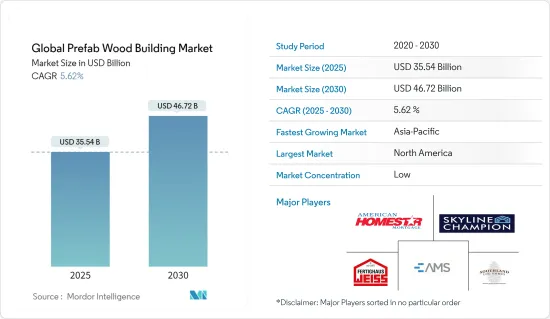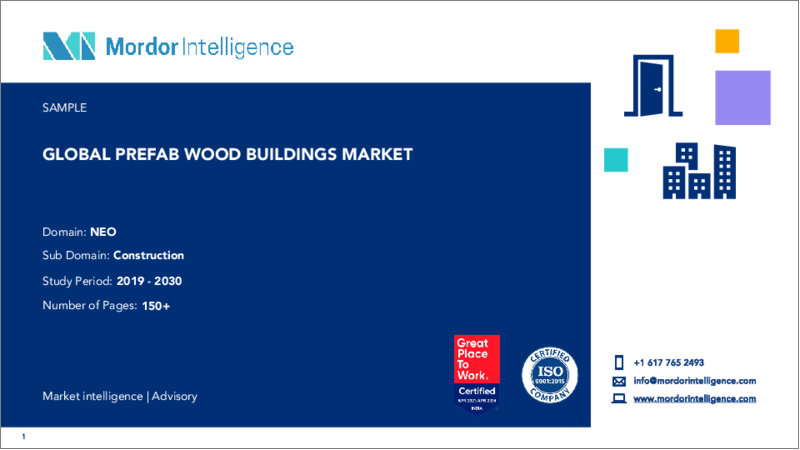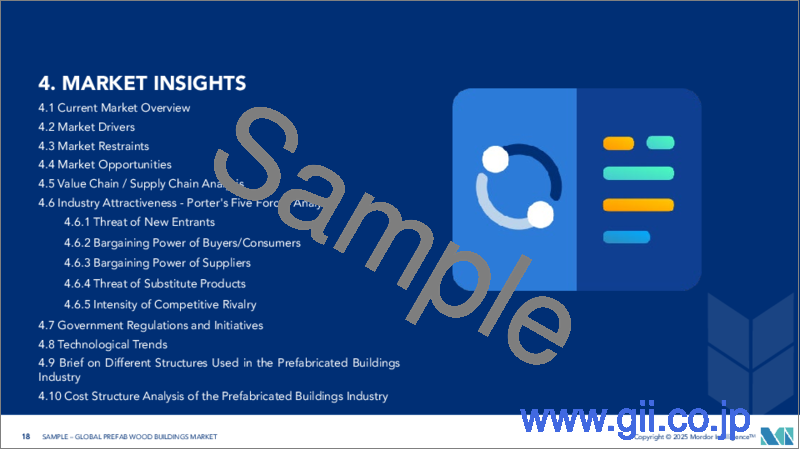|
|
市場調査レポート
商品コード
1644947
世界のプレハブ木造建築市場:市場シェア分析、産業動向と統計、成長予測(2025年~2030年)Global Prefab Wood Building - Market Share Analysis, Industry Trends & Statistics, Growth Forecasts (2025 - 2030) |
||||||
カスタマイズ可能
適宜更新あり
|
|||||||
| 世界のプレハブ木造建築市場:市場シェア分析、産業動向と統計、成長予測(2025年~2030年) |
|
出版日: 2025年01月05日
発行: Mordor Intelligence
ページ情報: 英文 150 Pages
納期: 2~3営業日
|
全表示
- 概要
- 目次
プレハブ木造建築の世界市場規模は、2025年に355億4,000万米ドルと推定され、2030年には467億2,000万米ドルに達すると予測され、予測期間中(2025~2030年)のCAGRは5.62%です。

主要ハイライト
- 世界中の建築家がポスト&ビームや集成材を採用するようになっており、プレハブ木造建築は最も早く簡単に建設できる建築物のひとつとなっています。木材は一年草であるにもかかわらず、伐採後も二酸化炭素を吸収し続ける。この特性により、木材は単なる建築資材ではなく、気候変動との闘いにおける強力な味方となります。
- 地球温暖化の原因となっている二酸化炭素排出の40%以上は、建設活動と建築作業によるものです。同時に、16億人が不十分な住宅に住み、1億人が住居を失っています。オーストラリアでも世界でも、住宅危機は依然として差し迫った未解決の課題です。しかし、プレハブ建築技術は、この二重のジレンマに解決策を提供する希望の光として浮上しています。
- 木造軸組工法は、米国、日本、ドイツなどで広く採用されています。この動向は、ARch Dailyが認定したフロリアノポリスのパークサイド・カルボエイラ・ビル(Parkside Carvoeira building in Florianopolis)が、ブラジルで最も高い木造フレーム・ビルのタイトルを誇らしげに保持していることからも明らかです。
- ブリティッシュコロンビア州(BC州)のサステイナブル森林管理から生まれたカナディアン・ウッドは、インド市場で信頼される木製品のサプライヤーです。スプルース・パイン・ファー(SPF)、ダグラス・ファー、ウェスタン・ヘムロック、ウェスタン・レッドシダー、イエローシダーなどの選択肢があり、どんなビジョンも実現可能です。
- 従来のプレハブ住宅の需要が急増する一方で、ログハウスは産業の重要な成長セグメントとして浮上してきました。1990年代後半、ログハウスは米国の注文住宅全体の約7%を占め、プレハブ・ログハウスの輸出は著しく増加しました。モジュール型住宅と同様、ログハウスも豊かさを増しています。しかし、ログハウスは伝統的構造の住宅よりも10%から20%多くの木材を消費するため、好んで使われる木材はますます不足しています。
世界のプレハブ木造建築市場動向
プレハブ木造建築市場をリードするカナダ
カナダのプレハブ木造建築市場は、主に先進的なパネルシステムの採用拡大により、上昇傾向にあります。その牽引役となっているのが、クロスラミネート・ティンバー(CLT)、ネイルラミネート・ティンバー(NLT)、ダウエルラミネート・ティンバー(DLT)、グルーラミネート・ティンバー(GLT)の柱と梁です。これらの材料は、その持続可能性と構造的完全性で有名であり、急速に全国の建築業者や建築家に選ばれるようになりました。
2024年10月に『Construction Business』誌で発表されたアルバータ州レッドディアのレッドディア・ポリテクニックの学生レジデンスを考えてみましょう。このカナダの住宅プロジェクトは、統合プロジェクトデリバリー(IPD)モデルによって実施され、共同による「利点による選択」(CBA)アプローチを活用しました。チームは、コンクリート、鉄骨、木造、複合システムを評価し、構造的に最適なものを決定しました。その結果、5階建ての中層ハイブリッドビルが完成しました。構造的な骨格となる柱と梁には集成材(GLT)、床と屋根にはGLTパネル、耐力壁、せん断壁、内装間仕切りにはディメンショナル・ランバーが採用されました。この意図的な選択は、カナダの建築においてプレハブ木造ソリューションの重要性が高まっていることを強調するもので、最小限のコストで最大のメリットをもたらしています。
ブリティッシュコロンビア州バンクーバーでは、もうひとつのハイブリッドプロジェクトであるウィーン・ハウスが、カナダ市場におけるプレハブ木造システムの重要性を強調しています。コンストラクションビジネス』誌が2024年10月に報じたように、このプロジェクトは、ほぼゼロ・エミッションの賃貸マンション・コミュニティとなる予定です。GLTではなくCLT(クロス・ラミネート・ティンバー)を選択したことで、ウィーン・ハウスはCLTの床・天井パネルとプレハブの軽量フレーム壁構造を一体化させています。この設計は環境に優しいだけでなく、高地震帯に位置することを考慮し、耐震補強用テンションロッドをシアウォールシステムに組み込んでいます。最終決定後、ウィーン・ハウスは家族用56戸を含む123戸を提供し、シェルターや低所得者向けから平均的な市場賃貸まで、多様なニーズに対応します。このイニシアチブは、プレハブ木造システムがカナダ国内の様々な建設需要に対応できる汎用性と効率性を強調しています。
結論として、カナダのプレハブ木造建築市場は急速に発展しており、CLTやGLTのような先進的なパネルシステムが極めて重要な役割を果たしています。これらの材料は構造効率を高めるだけでなく、カナダの持続可能性の目標にも合致しており、現代の建築手法に不可欠なものとなっています。レッドディア・ポリテクニックの学生寮やウィーン・ハウスのようなプロジェクトは、プレハブ木造システムの適応性、費用対効果、環境への配慮を浮き彫りにし、2024年以降のカナダ全土における市場の成長を牽引しています。
市場を牽引するパネルシステム
世界のプレハブ木造建築市場は、1,600以上の組織と23万1,600人を超える労働力を擁し、年間成長率は1.28%と若干落ち込んでいます。しかし、産業団体の報告によれば、過去5年間で、市場は300社以上の新規企業を迎え入れ、それぞれ平均18人の従業員を雇用しています。
データセンターで使用されるものを含むプレハブ木質パネルシステムは、耐火性のプレハブ木質材料であるCLT(cross-laminated timber)のような材料を利用するようになってきています。例えば、DCDが2024年10月に報じたように、Microsoftは自社のデータセンターに木材、鉄骨、コンクリートの組み合わせを採用し、従来の鉄骨造に比べ35%、標準的なプレキャストコンクリートに比べ65%の二酸化炭素排出量削減を見込んでいます。
CLTは建築材料として世界的に広く使用されているが、データセンターセグメントでの使用はまだ限られています。スウェーデンでは、EcoDataCenterとBoden TypeがデータセンターでのCLT使用の先駆者であり、アイスランドのいくつかの施設でもこの傾向が見られます。また、Vertivは独自のプレハブ式木造データセンター・モジュールを発表しています。EcoDataCenterの構造には木材が多用されているが、CLTはオフサイトでプレハブ化されるため、大規模な商業施設に一般的な波形鋼板よりも迅速で安全な設置が可能です。CLTは、従来の木材に比べて材料費が5~10%上昇する可能性があるが、建設期間の短縮による節約で、この割高感を相殺することができます。
結論として、世界のプレハブ木造建築市場は、特にパネルシステムセグメントにおいて、CLTのような革新的な材料によって進化しています。材料費の高騰といった課題はあるもの、工期短縮、持続可能性、安全性といったメリットが、データセンターを含むさまざまなセグメントでの採用を後押ししています。この動向は、同市場の成長の可能性と、環境に優しい建築プラクティスを推進する役割を浮き彫りにしています。
世界のプレハブ木造建築産業概要
プレハブ木造建築物市場はセグメント化されており、国内外の企業が数社存在します。これらの企業間の競合は激しいです。顧客は建築の絶え間ない改善とアップデートを求めているため、技術環境の急速な変化はプロバイダーに悪影響を及ぼすと予測されます。産業における確固たる存在感を維持するため、各社は提供する価値を変化させ、磨きをかけています。
米国や西欧を含む新興国市場では、市場の集中が顕著です。対照的に、中国やインドのような新興諸国は、このセグメントの黎明期を目の当たりにしています。大手企業は、購買とマーケティングの両面で規模の経済を活用しています。一方、中小企業は地域市場に特化したり、特化した商品を提供することで、ニッチを切り開いています。
大手企業には、Skyline Champion、American Homestar、Southland Log Homes、Fertighaus Weiss、American Modular Systems、Honkarakenne、松島臨港などがあります。
その他の特典
- エクセル形式の市場予測(ME)シート
- 3ヶ月間のアナリストサポート
目次
第1章 イントロダクション
- 調査の成果
- 調査の前提
- 調査範囲
第2章 調査手法
第3章 エグゼクティブサマリー
第4章 市場力学と洞察
- 現在の市場概要
- 市場促進要因
- 急速な都市化と人口増加
- 政府の取り組み
- 市場抑制要因
- 初期投資コストの高さ
- 規制上のハードル
- 市場機会
- 利害関係者の協力
- サプライチェーンの効率化
- バリューチェーン/サプライチェーン分析
- 産業の魅力-ポーターのファイブフォース分析
- 新規参入業者の脅威
- 買い手/消費者の交渉力
- 供給企業の交渉力
- 代替品の脅威
- 競争企業間の敵対関係
- 政府の規制と取り組み
- 技術動向
- プレハブ建築物産業で使用されるさまざまな構造概要
- プレハブ建築産業のコスト構造分析
- 地政学とパンデミックが市場に与える影響
第5章 市場セグメンテーション
- パネルシステム別
- クロスラミネートティンバー(CLT)パネル
- 釘打ち集成材(NLT)パネル
- ダボ集成材(DLT)パネル
- 集成材(GLT)柱・梁
- 用途別
- 一戸建て住宅
- 集合住宅
- オフィス
- ホスピタリティ
- その他
第6章 地域別
- 北米
- 米国
- カナダ
- メキシコ
- 欧州
- ドイツ
- フランス
- 英国
- イタリア
- スペイン
- ロシア
- その他の欧州
- アジア太平洋
- 中国
- 日本
- インド
- バングラデシュ
- トルコ
- 韓国
- オーストラリア
- インドネシア
- その他のアジア太平洋
- 中東・アフリカ
- エジプト
- 南アフリカ
- サウジアラビア
- その他の中東・アフリカ
- ラテンアメリカ
- ブラジル
- アルゼンチン
- コロンビア
- その他のラテンアメリカ
第7章 競合情勢
- 市場集中度概要
- 企業プロファイル
- Skyline Champion Corporation
- American Homestar
- Southland Log Homes
- Fertighaus Weiss
- American Modular Systems
- Palm Harbor Homes Inc
- Lester Building Systems
- Bouygues Construction
- Fleetwood Australia
- Clayton Homes, Inc.*
第8章 市場機会と今後の動向
第9章 付録
- マクロ経済指標(GDP分布、活動別)
- 対外貿易統計(輸出入、製品別)
- 主要輸出先と輸入原産国に関する洞察
The Global Prefab Wood Building Market size is estimated at USD 35.54 billion in 2025, and is expected to reach USD 46.72 billion by 2030, at a CAGR of 5.62% during the forecast period (2025-2030).

Key Highlights
- Architects worldwide are increasingly turning to post and beam and glued-laminated timbers, making prefabricated wooden buildings some of the quickest and easiest to construct. Despite being an annual, wood continues to sequester carbon dioxide even after being cut. This characteristic makes wood not just a construction material but a potent ally in the fight against climate change.
- Construction activities and building operations are responsible for over 40% of the carbon emissions fueling global warming. Simultaneously, 1.6 billion people reside in inadequate housing, with a staggering 100 million lacking shelter altogether. Both in Australia and worldwide, the housing crisis remains a pressing, unresolved challenge. Yet, prefabricated building technology emerges as a beacon of hope, offering solutions to this dual dilemma.
- The wood frame system enjoys widespread adoption in nations like the United States, Japan, and Germany. Highlighting this trend, the Parkside Carvoeira building in Florianopolis, recognized by ARch Daily, proudly holds the title of Brazil's tallest wood frame building.
- Canadian Wood, hailing from sustainably managed forests in British Columbia (B.C.), stands as a trusted supplier of wooden products in the Indian market. With options like Spruce-Pine-Fir (SPF), Douglas-fir, Western Hemlock, Western Red Cedar, and Yellow Cedar, turning any vision into reality becomes feasible.
- While the demand for prefabricated conventional homes has surged, log homes have emerged as a significant and growing segment of the industry. In the late 1990s, log homes constituted roughly 7% of all custom homes in the U.S., and exports of these prefabricated log homes witnessed a notable uptick. Much like modular homes, log dwellings have seen a rise in affluence. However, they consume 10% to 20% more wood than traditionally constructed houses, making their preferred wood increasingly scarce.
Global Prefab Wood Building Market Trends
Canada Leads the Charge in Prefab Wood Building Market
The prefab wood building market in Canada is on the rise, driven predominantly by the growing adoption of advanced panel systems. Leading this charge are materials such as Cross-Laminated Timber (CLT), Nail-Laminated Timber (NLT), Dowel-Laminated Timber (DLT), and Glue-Laminated Timber (GLT) columns and beams. Renowned for their sustainability and structural integrity, these materials have swiftly become the preferred choice for builders and architects across the country.
Consider the Red Deer Polytechnic Student Residence in Red Deer, Alberta, spotlighted by Construction Business in October 2024. This Canadian residential endeavor, executed via an integrated project delivery (IPD) model, utilized a collaborative 'Choosing by Advantages' (CBA) approach. The team evaluated concrete, steel, wood, and composite systems to determine the best structural fit. The outcome was a five-storey midrise hybrid building, featuring glue-laminated timber (GLT) posts and beams as its structural backbone, GLT panels for the floor and roof, and dimensional lumber for load-bearing walls, shearwalls, and interior partitions. This deliberate selection underscored the growing significance of prefab wood solutions in Canadian construction, delivering maximum benefits at minimal costs.
In Vancouver, British Columbia, another hybrid project, Vienna House, is underscoring the prominence of prefab wood systems in the Canadian market. As reported by Construction Business in October 2024, this project is set to be a near zero-emissions rental apartment community. By choosing Cross-Laminated Timber (CLT) over GLT, Vienna House is integrating CLT floor and ceiling panels with prefabricated light frame wall construction. The design not only champions eco-friendliness but also incorporates seismic reinforcing tension rods in the shearwall system, acknowledging its high seismic zone location. Once finalized, Vienna House will offer 123 units, including 56 family units, catering to a diverse range from shelter and low-income to average market rentals. This initiative underscores the versatility and efficiency of prefab wood systems in meeting varied construction demands within Canada.
In conclusion, the prefab wood building market in Canada is evolving rapidly, with advanced panel systems like CLT and GLT playing a pivotal role. These materials not only bolster structural efficiency but also align with Canada's sustainability objectives, making them integral to modern construction practices. Projects such as the Red Deer Polytechnic Student Residence and Vienna House highlight the adaptability, cost-effectiveness, and environmental consciousness of prefab wood systems, driving the market's growth across Canada in 2024 and beyond.
Panel Systems Feuling the Market
With over 1,600 organizations and a workforce exceeding 231,600, the global prefab wood building market is witnessing a slight annual growth rate dip of 1.28%. Yet, in the last five years, the market has welcomed over 300 new companies, each averaging an employment of 18 individuals as reported by Industry Associations.
Prefab wood panel systems, including those used in data centers, are increasingly utilizing materials like cross-laminated timber (CLT), a fire-resistant, prefabricated wood material. For instance, as reported by DCD, October 2024, Microsoft has adopted a combination of wood, steel, and concrete in its data centers, a move projected to reduce the facilities' embodied carbon footprint by 35% compared to traditional steel construction and by 65% compared to standard precast concrete.
While CLT is widely used as a building material globally, its application in the data center sector remains limited. In Sweden, EcoDataCenter and Boden Type are pioneering the use of CLT in their data centers, a trend echoed by several facilities in Iceland. Additionally, Vertiv has introduced its own prefabricated wooden data center module. While EcoDataCenter's construction leans heavily on wood, CLT's offsite prefabrication allows for swifter and safer installation than the corrugated steel prevalent in large commercial structures. Though CLT may elevate material costs by 5-10% over traditional timber, the savings from a shortened construction timeline can offset this premium.
In conclusion, the global prefab wood building market, particularly in the panel systems segment, is evolving with innovative materials like CLT. Despite challenges such as higher material costs, the benefits of reduced construction time, sustainability, and safety are driving its adoption across various sectors, including data centers. This trend highlights the market's potential for growth and its role in advancing eco-friendly construction practices.
Global Prefab Wood Building Industry Overview
The market for prefabricated wood buildings is fragmented, with several local and foreign firms. The competition among these players is intense. Customers want constant improvements and updates in construction, therefore the fast-changing technical environment is predicted to harm providers. To maintain a strong industry presence, companies are changing and refining their distinctive value offering.
Developed nations, including the United States and Western Europe, exhibit pronounced market concentration. In contrast, developing countries like China and India are witnessing the sector's nascent stages. Major corporations leverage economies of scale in both purchasing and marketing. Meanwhile, smaller enterprises carve out their niche by honing in on local markets or offering specialized items.
Some of the major players are Skyline Champion, American Homestar, Southland Log Homes, Fertighaus Weiss, American Modular Systems, Honkarakenne, and Matsushima Rinko.
Additional Benefits:
- The market estimate (ME) sheet in Excel format
- 3 months of analyst support
TABLE OF CONTENTS
1 INTRODUCTION
- 1.1 Study Deliverables
- 1.2 Study Assumptions
- 1.3 Scope of the Study
2 RESEARCH METHODOLOGY
3 EXECUTIVE SUMMARY
4 MARKET INSIGHTS AND DYNAMICS
- 4.1 Current Market Overview
- 4.2 Market Drivers
- 4.2.1 Rapid Urbanization and Population Growth
- 4.2.2 Government Initiatives
- 4.3 Market Restraints
- 4.3.1 High Initial Investment Costs
- 4.3.2 Regulatory Hurdles
- 4.4 Market Oppurtunities
- 4.4.1 Collaborative Stakeholders
- 4.4.2 Improving Supply Chain Efficiency
- 4.5 Value Chain / Supply Chain Analysis
- 4.6 Industry Attractiveness - Porter's Five Force Analysis
- 4.6.1 Threat of New Entrants
- 4.6.2 Bargaining Power of Buyers/Consumers
- 4.6.3 Bargaining Power of Suppliers
- 4.6.4 Threat of Substitute Products
- 4.6.5 Intensity of Competitive Rivalry
- 4.7 Government Regulations and Initiatives
- 4.8 Technological Trends
- 4.9 Brief on Different Structures Used in the Prefabricated Buildings Industry
- 4.10 Cost Structure Analysis of the Prefabricated Buildings Industry
- 4.11 Impact of Geopolitics and Pandemic on the Market
5 MARKET SEGMENTATION
- 5.1 By Panel Systems
- 5.1.1 Cross-laminated timber (CLT) panels
- 5.1.2 Nail-laminated timber (NLT) panels
- 5.1.3 Dowel-laminated timber (DLT) panels
- 5.1.4 Glue-laminated timber (GLT) columns and beams
- 5.2 By Application
- 5.2.1 Single Family Residential
- 5.2.2 Multi-family Residential
- 5.2.3 Office
- 5.2.4 Hospitality
- 5.2.5 Others
6 By Geography
- 6.1 North America
- 6.1.1 United States
- 6.1.2 Canada
- 6.1.3 Mexico
- 6.2 Europe
- 6.2.1 Germany
- 6.2.2 France
- 6.2.3 United Kingdom
- 6.2.4 Italy
- 6.2.5 Spain
- 6.2.6 Russia
- 6.2.7 Rest of Europe
- 6.3 Asia-Pacific
- 6.3.1 China
- 6.3.2 Japan
- 6.3.3 India
- 6.3.4 Bangladesh
- 6.3.5 Turkey
- 6.3.6 South Korea
- 6.3.7 Australia
- 6.3.8 Indonesia
- 6.3.9 Rest of Asia-Pacific
- 6.4 Middle East & Africa
- 6.4.1 Egypt
- 6.4.2 South Africa
- 6.4.3 Saudi Arabia
- 6.4.4 Rest of Middle East & Africa
- 6.5 Latin America
- 6.5.1 Brazil
- 6.5.2 Argentina
- 6.5.3 Columbia
- 6.5.4 Rest of Latin America
7 COMPETITIVE LANDSCAPE
- 7.1 Market Concentration Overview
- 7.2 Company Profiles
- 7.2.1 Skyline Champion Corporation
- 7.2.2 American Homestar
- 7.2.3 Southland Log Homes
- 7.2.4 Fertighaus Weiss
- 7.2.5 American Modular Systems
- 7.2.6 Palm Harbor Homes Inc
- 7.2.7 Lester Building Systems
- 7.2.8 Bouygues Construction
- 7.2.9 Fleetwood Australia
- 7.2.10 Clayton Homes, Inc.*
8 MARKET OPPORTUNITIES AND FUTURE TRENDS
9 APPENDIX
- 9.1 Macroeconomic Indicators (GDP Distribution, by Activity)
- 9.2 External Trade Statistics - Exports and Imports, by Product
- 9.3 Insights into Key Export Destinations and Import Origin Countries






